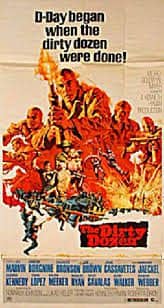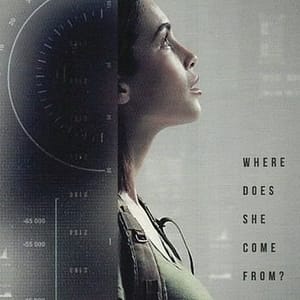MPAA Rating: NR/Genre: War/ Stars: Lee Marvin, Ernest Borgnine, Charles Bronson, Jim Brown, John Cassavetes, Richard Jaeckel, George Kennedy, Trini Lopez, Ralph Meeker, Robert Ryan, Telly Savalas, Donald Sutherland, Clint Walker, Robert Webber/ Runtime: 150 minutes
You know life is a funny thing when the far-gone year of 1967 paid witness not only to the infamous “summer of love”, but also saw a potent and quite violent war film released that, astonishingly, had a few psychos among its ragtag group of protagonists. Suffice it to say then that, ever since I first heard about The Dirty Dozen, I’ve kind of wanted to review this movie since I was a kid, but it’s taken me awhile to get to it. Yet it is one that me and a few of my friends always have enjoyed watching and honestly it doesn’t take much to see why. Indeed it’s because, long before The Expendables movies, this was one of the quintessential macho guy movies. Indeed this really is a type of movie that sadly does not get made a whole lot anymore, but really should. Indeed it’s weird to say, but unlike a lot of wartime or movies set during a war, it doesn’t have that many redeeming qualities about it, it’s pretty much a response to its initial audience’s feelings and attitudes to Vietnam, and it really does play less like a war film and more like a violent shoot’em up. Yet despite all of that, it is also perhaps, thanks to a phenomenal cast and crew, one of the finest war movies ever made. Indeed it may have inspired the DC Comics super group known as The Suicide Squad, but while we eagerly wait to see what James Gunn has done with his take on that group, then give this film a try in the interim. I promise you won’t regret it.
The plot is as follows: The Dirty Dozen introduces us to an officer by the name of Major Reisman. Major Reisman, it is worth noting, is a highly effective member of the U.S. Army except for the fact that he is not real fond of giving respect to his superiors. Thus when our story begins, Reisman is staring straight in the face of a court-martial, that terror of all U.S. military officers. Yet just when it looks like his career is all but done, he is given one more opportunity to show that he deserves to stay in the Army. An opportunity that consists of selecting a dozen of the worst offenders possible from a max-security Army prison, and then train them for a classified assignment behind enemy lines while also leading them on this mission. A mission that involves this rag-tag group being sent into Nazi-occupied France, infiltrating a château that has been converted into a sort of rest center for a lot of the upper echelons of the German Army, and then promptly assassinate as many of these officers as possible in as little time as necessary. However there is a positive to be had amidst all the destruction and carnage: should the mission be a success, any of the men who are still alive at the conclusion of it will promptly be released. Indeed for a character like Reisman, seeing as he is anti-authority in a lot of ways himself, sending men off to what literally amounts to a suicide mission is a tough pill to swallow, but he knows that it is the only way for him to still be able to have a career whereas for the men reluctantly under his command at least it’s a chance to either earn their freedom or at the very least to die trying……
Now suffice it to say that the men who make up this diverse squad really are an intriguing group yet astonishingly they all manage to do wonderful work including the unlikely additions of football legend Jim Brown and singer Trini Lopez. Yet even amongst an iconic cast such as this, there are still stand-outs to be found. This of course starts with team leader Lee Marvin, and it should come as no surprise to learn that he is in top form. Indeed Marvin manages to showcase a character who may be gruff, but does also have both a distinct sense of humor as well as a connection with his team in that none of them are overtly fond of that common ingredient in the Armed Forces known as authority and Marvin manages to incorporate all of that into a truly wonderful performance. Now I honestly have no idea who in their right mind thought bringing onboard Kojak himself, and not to mention the poster boy for New York, Telly Savalas as a southern religious nutjob (with a lot of emphasis on nutjob), but it manages to work astonishingly well and Telly manages to give a frighteningly good performance. Also turning in great work is both Charles Bronson who actually plays this one fairly low-key and does, typical for Bronson, a wonderful job as well as John Cassavetes, who as the team troublemaker, manages to give a performance that is truly wonderful and in fact I would say that his role is definitely one of the film’s standouts. Finally we also get wonderful work from genuine acting legend Donald Sutherland and even though his character is not really as three-dimensional as some of the other characters, but he does do a wonderful job of truly acting the fool in the majority of his screen time with particular regard to a scene where he masquerades as a general that I promise will have you rolling on the floor in laughter. We also get impressive work from a giant of a man by the name of Clint Walker, who looks like Paul Bunyan in the 1970’s, as a slightly backwoods behemoth who is a truly gentle giant….unless you shove him and then you might want to run the other way. Plus, as the group’s main defender and the main general who commissioned the creation of the group we get wonderful work from George Kennedy and Ernest Borgnine who, despite not having the biggest parts in the movie, manage to show that talent isn’t always determined by role size, but rather by the actor inhabiting the role in the first place. Indeed this truly is one of the more iconic casts for a war film, and they all manage to do absolutely phenomenal work.
Now even though it isn’t exactly a spoiler to reveal that Reisman and the majority of his reluctant squad do not see eye to eye in the slightest, they ultimately find themselves shanghai’d into working together in large part due to their mutual disdain: not only of the Nazis, but also several members of the upper echelon in the US Army who would love nothing more than to just see this men hung for their crimes. Indeed it is in making the latter an equally as imposing antagonist that the film’s director again chooses to rewrite the war film rule book once again by creating a riveting narrative which has the typical “good guys” be an antagonistical presence, and the typical “bad guys” be the protagonists thus giving this film the anti-establishment heart it so desperately craves. Not only that, but it also doesn’t hurt the movie in any way when it only has the Germans become a prevalent force in the film after the titular team has managed to earn the however begrudging respect of the generals and other officers who, until then, had written them off completely.
Now besides a terrific rogue’s gallery of characters and a fantastic and constantly riveting narrative, the movie really does benefit thanks to a superb partnership between the director and his cinematographer, a Mr. Edward Scaife, as they really manage to work in synchronicity at making every shot as effective as possible. Indeed not only do the constricted and musty cells in the first part feel entirely plausible and the giant yet glamorous Nazi-held château give off the vibe of being a wonderful mix of both a glorious estate as well as an unconquerable fort, but even the moments of conflict have a terrific sense of choreography about them as well. Indeed rarely if ever does a minute in this film go by where we have simply no idea where something is occurring and how it ties into what the rest of this team is occupied with doing both on the inside and outside of the Château. We also get a truly magnificent score courtesy of Frank de Vol that, although not used often, is able to add comedy and thrills to the film whenever it is utilized. Not only that, but music is also utilized to quite brilliant effect in a scene where Donald Sutherland’s character is allowed to “inspect” a platoon from the 82nd Airborne, and things go….shall we say comically awry for lack of a better word. Indeed suffice it to say then the team in front of the camera may be iconic, but they owe a huge debt to the team behind the camera for making that possible in the first place.
All in all I think it is safe to say that when you get right down to it, war is quite the filthy endeavor and this is a film about just that. Indeed this isn’t a film that deals with a group of guys who go into combat and play by the rules. Rather, they choose instead to break every single rule in that book in order to see that the mission is complete and should a few innocents get in their way, then they are unfortunate yet necessary collateral damage. Yet on a much deeper level, I also feel that this terrific film is also a brilliant embodiment of the cultural feelings that were swirling around in the late 60’s. Indeed movie lovers desperately craved a film which, among other things, said it was ok to break the rules whilst also showing the upper echelons of the American military hierarchy as flawed and also pompous in nature and transformed a group of individuals who the military would normally frown upon into no less than the heroes of the movie. Indeed The Dirty Dozen may be a cynical look back at the era in which it was made, but this is a movie which still holds up marvelously all these years later perhaps because the world we live in is one that I would wager has been molded by the very same attitudes that are showcased in this film from beginning to end. Thus, as I said at the beginning of this review, isn’t it just a wee bit ironic to note that this anti-war war film is also, thanks to dynamite work from the cast and crew, one of the best war films ever made? Upon seeing it I can safely say: I think not…On a scale of 1-5 I give The Dirty Dozen “67” a solid 4.5 out of 5.



